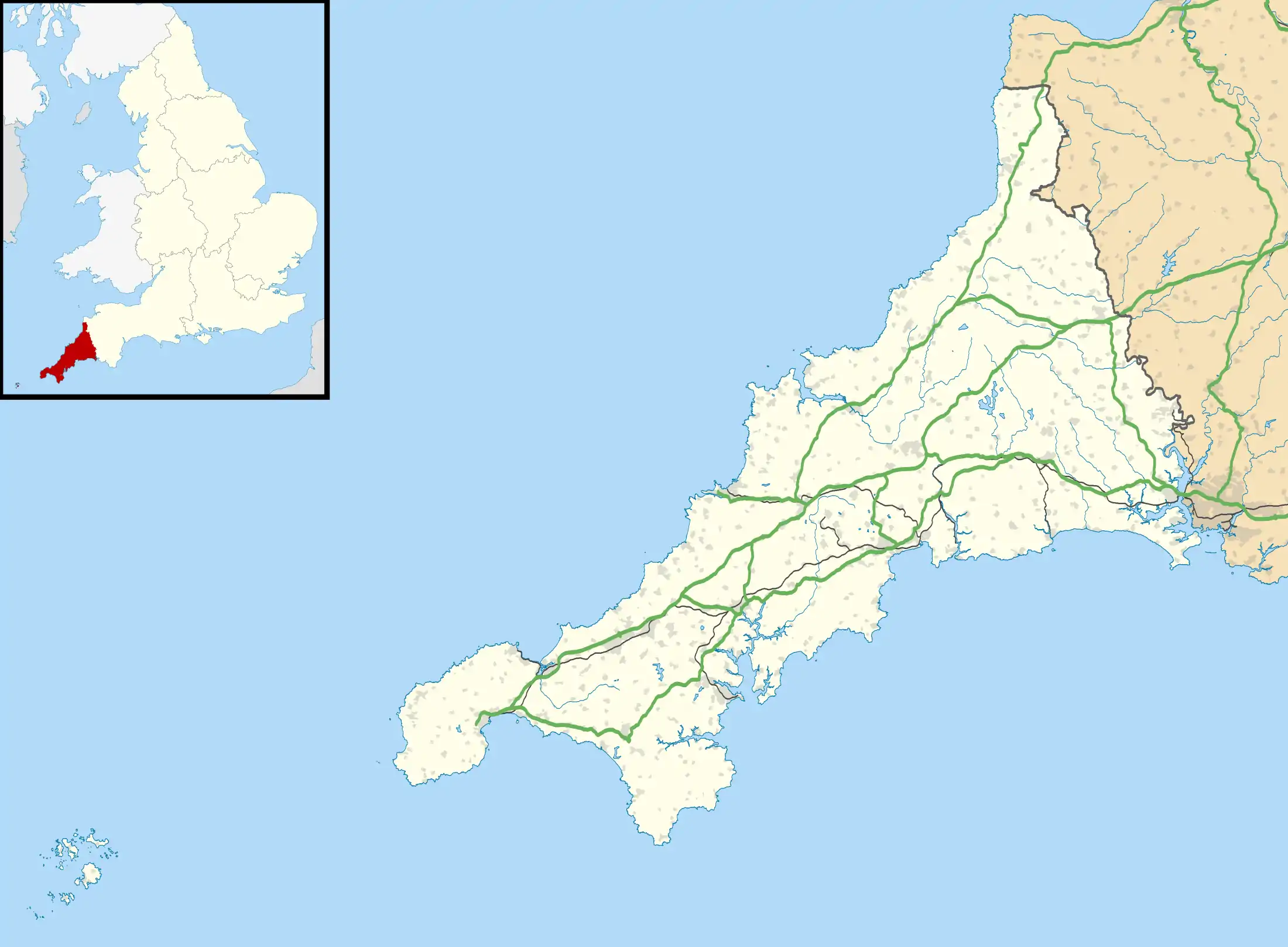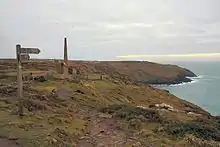Botallack Mine
The Botallack Mine (Cornish: Bostalek) is a former mine in Botallack in the west of Cornwall, England, UK. Since 2006 it has been part of the UNESCO World Heritage Site – Cornwall and West Devon Mining Landscape. The mine is within the Aire Point to Carrick Du Site of Special Scientific Interest (SSSI) and the South West Coast Path passes along the cliff.
| Botallack Mine | |
|---|---|
 Engine houses at Crown Mines | |
| Type | industrial heritage, mine |
| Coordinates | 50°8′24″N 5°41′27″W |
| Owner | National Trust |
| Type | Cultural |
| Criteria | ii, iii, iv |
| Designated | 2006 (30th session) |
| Part of | Cornwall and West Devon Mining Landscape |
| Reference no. | 1215 |
| United Kingdom | List of World Heritage Sites in Western Europe |
Listed Building – Grade II | |
 Location of Botallack Mine in Cornwall | |

Location
The village of Botallack is on the B3306 road, in a former tin and copper mining area between the town of St Just in Penwith and the village of Pendeen.[1]
History
Botallack was a submarine mine with tunnels extending under the sea, in places for half a mile. Over its recorded lifetime the mine produced around 14,500 tonnes of tin, 20,000 tonnes of copper, and 1,500 tonnes of arsenic. An estimated 1.5 million tonnes of waste would have been dug up with the minerals.[2] It is unclear how far back mining activity goes in this location. Early records date from the 1500s. Some archaeological evidence points to mining here in the Roman era or even as far back as the Bronze Age.[2]
Henry Boynes was captain of the mine in the early 18th-century and opened a ″deep adit level,″ which was driven to the Corpus Christi lode in the higher mine. The first steam-engine was put to work at Carnyorth Moor (later part of the Botallack sett) in either 1795 or about 1810, depending on the source. In the first half of the 19th-century, the average price of Botallack tin was £64 4s a ton. The abolition of tin duty of 4s per 120 lbs to the Duke of Cornwall in 1838 helped to keep the mine operating despite a decline in the price of tin to £45 per ton.[3] In the 1860s a new diagonal shaft was dug. A visit by the Prince and Princess of Wales in 1865, when they descended the shaft, created a mini-boom in tourism, causing the mine operators to charge visitors a guinea per person.[2]
An increasing supply of tin – initially from Malaysia, Banka Island, and Sumatra, and in the 1870s onwards from Australia – along with a fall in demand for tinplate in the American market, caused the price of tin to fall, causing many Cornish mines to close.[3] The managers decided in January 1883 to stop the Botallack and Crowns engines, because the number of men employed below ground was not sufficient to meet the costs of keeping the engines going.[4] On 2 October 1883 the recently renewed setts, which extended over 2 miles (3.2 km) – comprising Wheal Cock, the Crowns, Carnyorth and Higher Mine – were put up for auction as a ″going concern.″ It included four pumping and three winding engines, two steam stamps, plus other appliances. At the auction it was stated that the mine ″... only needs from £20,000 to £25,000 to be put in good working order, ...″ There were no bids for the mine.[5][6]
The following shafts were working in 1884,
- Botallack engine-shaft, 220 fathoms (1,320 ft; 400 m) deep and worked with a 30 inches (760 mm) cylinder
- Crowns engine-shaft, 130 fathoms (780 ft; 240 m) deep and worked with a 36 inches (910 mm) cylinder
- Wheal Cock engine-shaft, 160 fathoms (960 ft; 290 m) deep and worked with a 30 inches (760 mm) cylinder
- Carnyorth engine-shaft, 130 fathoms (780 ft; 240 m) deep and worked with a 30 inches (760 mm) cylinder
- Wheal Cock skip-shaft, 170 fathoms (1,020 ft; 310 m) deep
- Botallack skip-shaft, 205 fathoms (1,230 ft; 375 m) deep
- Carnyorth skip-shaft, 124 fathoms (744 ft; 227 m) deep
- Wheal Hazzard skip-shaft, 100 fathoms (600 ft; 180 m) deep
- Chy Cornish skip-shaft, 100 fathoms (600 ft; 180 m) deep
- Pearce's skip-shaft, 130 fathoms (780 ft; 240 m) deep
- Bullion skip-shaft, 185 fathoms (1,110 ft; 338 m) deep
- Durloe skip-shaft, 70 fathoms (420 ft; 130 m) deep
- Rodd's skip-shaft, 60 fathoms (360 ft; 110 m) deep
- Boscawen diagonal-shaft, about 500 fathoms (3,000 ft; 910 m) long, perpendicular depth 240 fathoms (1,440 ft; 440 m) and 300 fathoms (1,800 ft; 550 m) under the sea
- Approximately 10 other shafts varying in depth from a few fathoms to 50 fathoms (300 ft; 91 m) deep.[7]
Other engines,
- Botallack stamping-engine, 30 inches (760 mm) cylinder
- Carnyorth stamping-engine, 24 inches (610 mm) cylinder
- Carn whim, 27 inches (690 mm) cylinder
- Davy's whim (Botallack), 26.5 inches (670 mm) cylinder
- Carnyorth, 22 inches (560 mm) cylinder
- saw-mill, 14 inches (360 mm) cylinder
- air-compressor, 14 inches (360 mm) cylinder.
A total of 265 were employed and the monthly wage was approximately £800 per month.[7]
| Men | Boys | Girls | Total | |
|---|---|---|---|---|
| Underground | 140 | 20 | 0 | 160 |
| Surface, dressing ore | 18 | 20 | 17 | 55 |
| Surface, other | 45 | 2 | 3 | 50 |
The average monthly yield of the mine was about 19 tons of tin, 3 tons of copper and 4 tons of arsenic.[7]
The mine closed in 1895 as a result of falling tin and copper prices.[2]
The mining developments around Botallack form part of the St Just mining district's successful inclusion in the Cornwall and West Devon Mining Landscape World Heritage site, which was inscribed in July 2006.[2]
Description
The engine houses in the Crowns section of Botallack Mine are set low down the cliffs north of Botallack. There are two engine houses and the remains of another pair on the cliff slopes above; the mine extends for about 400 metres out under the Atlantic ocean; the deepest shaft is 250 fathoms (about 500 metres) below sea level. The workings of Botallack Mine extend inland as far as the St Just to St Ives road, and at times included Wheal Cock further to the north-east.
The mine buildings on Botallack Cliffs are protected by the National Trust. There are two arsenic works opposite the Botallack Mine count house. At the top of the cliffs there are also the remains of one of the mine's arsenic-refining works.[8]
The mineral Botallackite has its type locality here.[9]
Culture
The 1970s BBC television series Poldark was filmed partly in Botallack, using Manor Farm as Nampara.[10] More recently, filming for the new Poldark series also took place here.[2]
References
- OS Explorer 102 Land's End (Map). Southampton: Ordnance Survey. 2015. ISBN 978 0 319 24304 6.
- "Botallack". National Trust. Retrieved 3 December 2016.
- Boynes (alias Ouit) (15 November 1883). "The Industries of Penzance and its Neighbourhood. No XX. The MIning of St. Just. I – History of the District". The Cornishman (279). p. 6.
- "The Stoppage Of Part Of Botallack". The Cornishman (236). 18 January 1883. p. 5.
- "Sale by Auction. Botallack, Cornwall". The Cornishman (269). 6 September 1883. p. 1.
- "Botallack In The Market". The Cornishman (273). 4 October 1883. p. 5.
- Boynes (alias Ouit) (20 March 1884). "The Industries of Penzance and its Neighbourhood. No XX. The Mines of St Just. 5-Botallack Mine. (concluded)". The Cornishman (297). p. 6.
- "Seven Man Made Wonders". BBC. Retrieved 3 December 2016.
- "Botallackite". mindat.org. Hudson Institute of Mineralogy. Retrieved 3 December 2016.
- "Film & Television Locations in Cornwall". Cornwall Calling. Retrieved 3 December 2016.
External links
 Media related to Botallack Mine at Wikimedia Commons
Media related to Botallack Mine at Wikimedia Commons